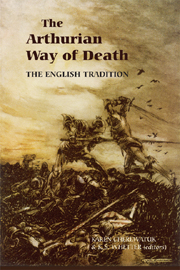Book contents
- Frontmatter
- Contents
- Illustrations and Tables
- Dedication
- List of Contributors
- Introduction
- Part I The early Tradition in england
- Part II Middle English Romance and Malory
- 4 ‘Hadet with an aluisch mon’ and ‘britned to noℨt’: Sir Gawain and the Green Knight, Death, and the Devil
- 5 Love and Death in Arthurian Romance
- 6 Death in the Margins: Dying and Scribal Performance in the Winchester Manuscript
- 7 The Legible Corpses of Le Morte Darthur
- 8 Malory and the Death of Kings: The Politics of Regicide at Salisbury Plain
- 9 ‘Layde to the Colde Erthe’: Death, Arthur's Knights, and Narrative Closure
- Part III Medieval Influence and Modern Arthuriana
- Index
- Arthurian Studies
5 - Love and Death in Arthurian Romance
from Part II - Middle English Romance and Malory
Published online by Cambridge University Press: 12 September 2012
- Frontmatter
- Contents
- Illustrations and Tables
- Dedication
- List of Contributors
- Introduction
- Part I The early Tradition in england
- Part II Middle English Romance and Malory
- 4 ‘Hadet with an aluisch mon’ and ‘britned to noℨt’: Sir Gawain and the Green Knight, Death, and the Devil
- 5 Love and Death in Arthurian Romance
- 6 Death in the Margins: Dying and Scribal Performance in the Winchester Manuscript
- 7 The Legible Corpses of Le Morte Darthur
- 8 Malory and the Death of Kings: The Politics of Regicide at Salisbury Plain
- 9 ‘Layde to the Colde Erthe’: Death, Arthur's Knights, and Narrative Closure
- Part III Medieval Influence and Modern Arthuriana
- Index
- Arthurian Studies
Summary
As Dante and Virgil traverse the Second circle of Hell, that devoted to the punishment of lust, Dante is shown the many souls ‘ch'Amor di nostra vita dipartille’ (‘whom Love parted from our life’); overcome by pity, Dante asks to speak to two of the lovers, and the woman relates how:
Amor, ch'al cor gentil ratto s'apprende, prese costui de la bella persona che mi fu tolta, e 'l modo ancor m'offende. Amor, ch'a nullo amato amar perdona, mi prese del costui piacer sì forte che, come vedi, ancor non m'addandona. Amor, condusse noi ad una morte.
Love, which is swiftly kindled in the noble heart, seized this one for the lovely person that was taken from me; and the manner still injures me. Love, which pardons no one loved from loving in return, seized me for his beauty so strongly that, as you see, it still does not abandon me. Love led us on to one death.
Death and dying, as this collection of essays is designed to show, are common topics and themes in Arthurian literature. One way these themes manifest themselves is through the association of death and love. As my opening quotation from Dante is meant to acknowledge, neither death nor love nor the possible association between them is unique to Arthurian legend, and Dante's lovers serve as touchstones for the prominence in medieval narrative as a whole of the theme of love and death.
- Type
- Chapter
- Information
- The Arthurian Way of DeathThe English Tradition, pp. 94 - 114Publisher: Boydell & BrewerPrint publication year: 2009



